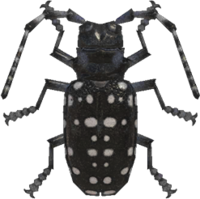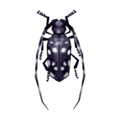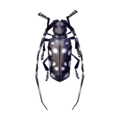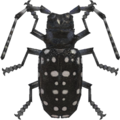Citrus long-horned beetle
The citrus long-horned beetle (known as the longhorn beetle prior to New Horizons) is a bug in the Animal Crossing series that first appears in Doubutsu no Mori. In games prior to Animal Crossing: City Folk it can be found on trees, and beginning in City Folk it can be found on tree stumps. In Animal Crossing: New Horizons, it can be caught year-round.
Catch details[edit]
In Animal Crossing[edit]
In Wild World[edit]
| Description | They get their name from their large antennae. Their strong bite comes from chewing wood. |
|---|---|
| Time of year | Jun – Aug |
| Time of day | Jun: 8 AM – 7 PM Jul – Aug: 8 AM – 5 PM |
| Peak times | N/A |
| Location | On trees |
| Bug size | 30 mm |
| Selling price | |
| Furniture size |
In City Folk[edit]
| Description | The secret to the strong jaws of these insects is all the wood they eat. |
|---|---|
| Time of year | Jul – Aug |
| Time of day | 11 PM – 7 PM |
| Peak times | N/A |
| Location | On tree stumps |
| Bug size | 30 mm |
| Rarity | Very uncommon |
| Selling price | |
| Furniture size |
In New Leaf[edit]
| Time of year | Jul – Aug All year (Tortimer Island) |
|---|---|
| Time of day | 11 PM – 7 PM |
| Peak times | N/A |
| Location | On tree stumps (can be found on Tortimer Island) |
| Size | 52 mm |
| Rarity | Very common |
| Selling price | |
| Furniture size |
In New Horizons[edit]
| Time of year | North: All year South: All year |
|---|---|
| Time of day | All day |
| Location | On tree stumps |
| Weather | Any except rain |
| Spawn requirement | Appears from the start of the game |
| Selling prices | |
| Furniture size |
Donating to the museum[edit]
As with all insects in the Animal Crossing series, the citrus long-horned beetle can be donated to the museum followed by a small talk by Blathers, the curator.
In Animal Crossing[edit]
In Wild World[edit]
After Blathers reluctantly accepts the longhorn beetle, it can be found on the third tree from the right in the second room of the bug exhibit. It sits placidly on its tree, but does shuffle about on the spot quite a bit.
In City Folk[edit]
After donation, it can be found on the second tier of the insect section of the museum, in the middle enclosure containing two trees and a tree stump, on the tree stump with the violin beetle. This enclosure also contains the walking leaf and oak silk moth, to name a few others.
In New Leaf[edit]
Upon donation, it can be found on the large tree stump in the upper left room of the insect exhibit. The information board has this to say about the longhorn beetle:
In New Horizons[edit]
Once donated to the museum, the citrus long-horned beetle can be found on a tree stump next to the rosalia batesi beetle and the jewel beetle.
Gallery[edit]
Real-world information[edit]
The genus is the Anoplophora of the longhorn, the Cerambycidae is the family. Native to China, the Asian long-horned beetle causes severe damage to America's trees. The beetle can launch itself as far as 400 meters, in search for a tree to lay eggs in. As they grow up, they wiggle out of trees, eating sap, laying waste, and making deep, wide holes.
The citrus long-horned beetle (Anoplophora chinensis) is a long-horned beetle native to Japan, China and Korea, where it is considered a serious pest.
Each female citrus long-horned beetle can make up to 200 eggs after mating, and each egg is separately deposited in tree bark. After the beetle larvae hatches, it chews into the tree, forming a tunnel that is then used as a place for beetle pupation (the process of growing from larvae to adult). From egg-laying to pupation and adult emergence can take twelve to eighteen months.
Infestations by the beetle can kill many different types of hardwood trees as well as citrus trees, pecan, apple, Australian pine, hibiscus, sycamore, willow, pear, mulberry, pigeon pea, Chinaberry, poplar, litchi, kumquat, Japanese red cedar, oak, and Ficus.
More information on this topic is available at Wikipedia.
Names in other languages[edit]
Longhorn beetle[edit]
| Longicorne | Longhorn |
Citrus long-horned beetle[edit]
| ゴマダラカミキリ gomadara kamikiri |
Citrus long-horned beetle (lit. "black-speckled long-horned beetle") | |
| 알락하늘소 allakhaneulso |
Citrus long-horned beetle (lit. "speckled long-horned beetle") | |
| 星天牛 xīngtiānniú |
Citrus long-horned beetle (lit. "starry long-horned beetle") | |
| Цитрусовый усач Tsitrusovyy usach |
Citrus long-horned beetle | |
| Aziatische boktor | Asian long-horned beetle | |
| Fichtenbock | Long-horned beetle | |
| Longicornio asiático | Asian long-horned beetle | |
| Capricorne des agrumes | Citrus long-horned beetle | |
| Tarlo asiatico | Asian long-horned beetle | |
Notes[edit]
- ↑ All bugs and fish in the first-generation games can appear at a lower spawn rate up to five days before the start of their first month of availability.
| Bugs | ||||||||||||||||||||||||||
|---|---|---|---|---|---|---|---|---|---|---|---|---|---|---|---|---|---|---|---|---|---|---|---|---|---|---|
| ||||||||||||||||||||||||||









